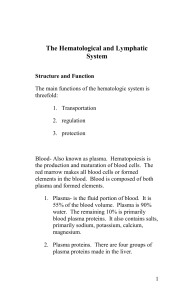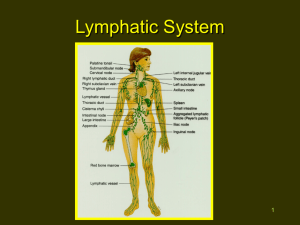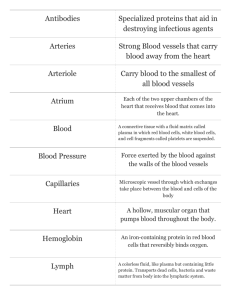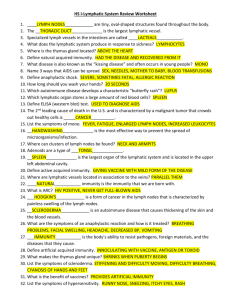Lymphatic System
advertisement
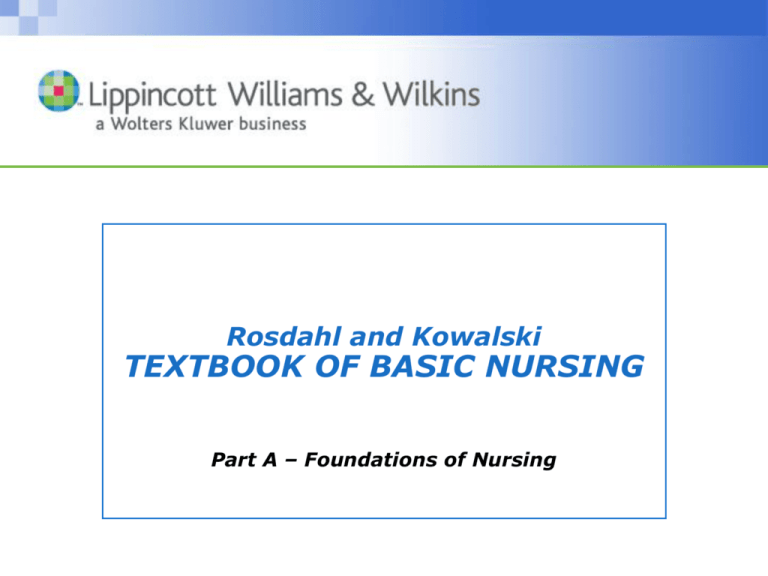
Rosdahl and Kowalski TEXTBOOK OF BASIC NURSING Part A – Foundations of Nursing CHAPTERS: Unit 4 Structure and Function 15. Organization of the Human Body 16. The Integumentary System 17. Fluid and Electrolyte Balance 18. The Musculoskeletal System 19. The Nervous System 20. The Endocrine System 21. The Sensory System 22. The Cardiovascular System CHAPTERS: Unit 4 Structure and Function 23. The Hematologic and Lymphatic Systems 24. The Immune System 25. The Respiratory System 26. The Digestive System 27. The Urinary System 28. The Male Reproductive System 29. The Female Reproductive System Learning Objectives 1. Describe the principal functions of the blood and its mechanisms to maintain homeostasis. 2. Identify the four plasma proteins and their chief functions. 3. Outline the structure and function of the red blood cells, white blood cells, and platelets. 4. Discuss the importance of chemotaxis and phagocytosis in fighting invading organisms. Learning Objectives, cont. 5. Describe the mechanism of blood clotting. 6. Identify the four blood groups and explain the Rh factors. 7. Describe the blood groups that are considered the universal donor and the universal recipient and state why this is so. 8. Describe lymphatic circulation and the filtration role of the lymph nodes. Learning Objectives, cont. 9. Describe the circle of Willis and the blood–brain barrier, including the function of each. 10. Explain the process of hepatic–portal circulation. 11. Discuss at least three normal changes in the hematologic and lymphatic systems caused by aging. New Terminology • agglutination • fibrin • albumin • fibrinogen • anastamose • globulin • coagulation • hematopoiesis • crossmatching • hemorrhage • embolus • hemostasis • endocytosis • leukocyte • erythrocyte • lymph New Terminology, cont. • lymph node • prothrombin • lymphocyte • Rh factor • monocyte • spleen • phagocytosis • thrombin • pinocytosis • thrombocyte • plasma • thrombus • platelet • tonsil Acronyms • BBB • Hb • Hgb • MABP • RBC • Rh+ • Rh– • WBC Hematologic System • Consists of – The components of the blood (plasma and formed elements) – The bone marrow, the primary organ that manufactures blood cells Lymphatic System • Consists of the lymphatic vessels and tissues • Other organs and structures, such as the spleen, liver, and kidneys, also perform specific functions related to these systems. Functions of the Hematologic and Lymphatic Systems See Box 23-1. Key Concept • The hematologic and lymphatic systems have transportation and protective functions in the body. • Also, blood functions in regulatory processes in the body, and lymph functions in the manufacture of formed elements and the absorption and storage of substances in the body. Blood • Blood is a versatile vascular fluid that is heavier, thicker, and more viscous than water. • Has an adhesive quality that contributes to its ability to form solid clots • Primary objective of blood is to maintain a constant environment for the rest of the body’s tissues • It maintains this homeostasis via its viscosity (thickness), its ability to carry dissolved substances, and its ability to move to all body parts. Blood, cont. • Responsible for the transportation to and from the cells of – Oxygen – Carbon dioxide – Nutrients – Heat – Waste products – Hormones Blood, cont. • Helps regulate – pH – Body temperature – Cellular water content • Protection from blood loss and foreign body invasion Blood, cont. • Considered a connective tissue • Differs from other connective tissues – Cells are not fixed – Cells move freely in plasma, the liquid portion of the blood Hematopoiesis (Hemopoiesis) • Hematopoiesis: production and maturation of blood cells • The red bone marrow manufactures all blood cells, or formed elements, in blood. • Blood is composed of both plasma and formed elements. • Blood carried through a closed system of vessels pumped by the heart – Volume of circulating blood differs with individual body size – Average adult body contains about 4 to 6 L Key Concept • Blood is composed of plasma and formed elements. Plasma • Fluid portion of circulating blood • Consists of 90% water • 10% consists primarily of plasma proteins • Constitutes 55% of blood volume • Also includes – Salts (electrolytes) – Nutrients – Nitrogenous waste products – Gases – Hormones – Enzymes Plasma, cont. • Salts contained in the plasma – Sodium (Na+) – Calcium (Ca+) – Potassium (K+) – Magnesium (Mg++) Plasma, cont. • Plasma absorbs these salts from food for use by body cells. • Maintenance of these salts within the plasma – Controls the chemical and acid–base balance of the blood – Contributes to the body’s chemical and fluid balance Plasma, cont. • Contains ions of other elements in the form of – Bicarbonates – Sulfates – Chlorides – Phosphates (see Chap. 17) Plasma Proteins • Manufactured in liver • Four groups of plasma proteins – Albumin – Fibrinogen – Prothrombin – Globulin Plasma Proteins, cont. • Albumin - 60% to 80% of plasma proteins – Function: to provide thickness to the circulating blood volume • Thickness of albumin provides osmotic pressure • Osmotic pressure draws water from surrounding tissue fluid into capillaries. Therefore, osmotic pressure maintains fluid volume and blood pressure. • Loss of albumin can result in dramatic fluid shifts, edema, hypotension, and even death. Plasma Proteins, cont. • Fibrinogen – Essential for blood clotting • Prothrombin – Essential for blood clotting Plasma Proteins, cont. • Globulin – Alpha and beta globulin • Made in the liver • Act as carriers for molecules such as fats – Gamma globulins or immunoglobulins (Ig) • Are antibodies, which are made by the body in response to foreign invaders (antigens) • Antibodies provide immunity against infection and disease. Key Concept • Albumin, the largest group of plasma proteins, helps maintain blood pressure and circulating fluid volume. • The three other circulatory plasma proteins are fibrinogen, prothrombin, and globulin. Formed Elements • Remaining 45% of blood volume consists of – Formed elements • Red blood cells (RBCs) or erythrocytes • White blood cells (WBCs) or leukocytes • Platelets or thrombocytes Normal Types of Blood Cells (Insert Figure 23-1) Formed Elements: RBC • Red blood cells or erythrocytes – Erythro = red; cyte = cell – Flattened, biconcave disks – When RBCs mature, they have no nucleus. – Most numerous of the blood cells – Made from stem cells in red bone marrow Formed Elements: RBC, cont. – Life of an individual RBC is about 120 days – Each RBC contains molecules of the compound hemoglobin (Hgb or Hb), which is composed of • Iron-containing pigment heme • A protein, globin – Iron is the pigment that makes RBCs appear red Formed Elements: RBC, cont. • As blood passes through the lungs – The iron in hemoglobin picks up oxygen in a loose chemical combination – When hemoglobin is saturated with oxygen, the blood is bright red. – As blood circulates through the capillaries, the hemoglobin gives its oxygen to various cells of the body and picks up their carbon dioxide. – The deoxygenated blood is darker red in color. Key Concept • Iron in the hemoglobin picks up oxygen in the lungs. This oxygen is exchanged for carbon dioxide at the cellular level and returned to the lungs to complete the cycle. Formed Elements: WBC • White blood cells or leukocytes – Leuko = white; cyte = cell – Defend the body against disease organisms, toxins, and irritants – Contain nuclei and can move independently in an ameboid fashion – Assist in repairing damaged tissues – Sometimes they die during this activity and collect with bacteria to form pus. Types of WBCs • Granular leukocytes (granulocytes) – Basophils – Eosinophils – Neutrophils • Agranular leukocytes (agranulocytes) – Leukocytes – Monocytes • 5 subgroups of WBCs – Basophils – Eosinophils – Neutrophils – Leukocytes – Monocytes WBC: Granulocytes • Basophils – Involved in allergic and inflammatory reactions – Contain heparin (anticoagulant) – Release histamine when foreign invader in body – These substances cause inflammatory or hypersensitivity reaction in the body resulting in vasodilation and edema, itching, and possibly bronchial constriction • These signs and symptoms are the result of an allergic or inflammatory response. WBC: Granulocytes, cont. • Eosinophils – Speckled or grainy cytoplasm – Survive only about 12 hours to 3 days – Increase in number during allergic reactions and parasitic infections – May also release chemicals to assist the body in detoxifying foreign proteins or engulfing and devouring invaders (endocytosis: phagocytosis or pinocytosis) – May also have a role in decreasing the release of chemical mediators during allergic reactions WBC: Granulocytes, cont. • Neutrophils – Most numerous – Can also be called • Polymorphonuclear neutrophils (PMNs) • Segmented neutrophils (segs) – Considered to be first in the line of defense against bacteria WBC: Granulocytes, cont. • Neutrophils, cont. – Increase in number during bacterial infections, burns, or inflammation – Short lifespan (approximately 10 hours); need to be replaced frequently – In infection, more neutrophils are released from the bone marrow. – When the demand for these granulocytes is very high, the bone marrow releases immature neutrophils called bands. WBC: Granulocytes, cont. • Neutrophils, cont. – Have ability to move away from blood vessels – Can move directly to sites of infection by their attraction to certain chemical substances (chemotaxis) – To fight bacterial infections, they increase in number, and engulf and devour invaders (phagocytosis or endocytosis). – In WBC counts, an increased number of bands (immature neutrophils), also called “shift to the left,” indicates a significant infection Phagocytosis (Insert Figure 23-2) WBC: Agranulocytes—Monocytes • Two subgroups: monocytes and lymphocytes • Monocytes – Transformed into macrophages, which are phagocytic cells – Play a role in acute and chronic inflammatory processes – High monocyte count may be due to a viral or fungal infection, tuberculosis, or chronic diseases WBC: Agranulocytes—Lymphocytes • Lymphocytes – Normal conditions: lifespan about 100 to 300 days – Produced in the lymphatic tissue of the spleen, lymph nodes, and thymus and in the hemopoietic tissues in red bone marrow – Differentiated into various types WBC: Agranulocytes—Lymphocytes, cont. – Various subgroups of lymphocytes, the most important of which are • B lymphocytes (B cells) • T lymphocytes (T cells) • Play an important role in the immune response – Lymphocytes increase in number during infectious processes that might be caused by viral infections or immune diseases. Key Concept Granular leukocytes • Basophils—involved in the inflammatory process and allergic reactions • Eosinophils—involved in allergic reactions and parasitic infections • Neutrophils—involved in phagocytosis; defense against bacteria Agranular leukocytes • Monocytes—transformed into macrophages; involved in phagocytosis • Lymphocytes—involved in immune responses WBC: Thrombocytes • Platelets or thrombocytes – Thrombo = clot; cyte = cell – Smallest of blood’s formed elements – Not whole cells but fragments of larger cells – Lack nuclei but are capable of ameboid movement – Formed in red bone marrow – Essential for blood clotting Blood Clotting and Hemorrhage • Hemostasis: the cessation of bleeding – Occurs when blood vessels damaged or ruptured – Hemostatic response is quick and carefully controlled – Hemostatic initial response includes • Vascular spasm (vasoconstriction) • Platelet plug formation • Blood clotting (the coagulation process that forms a fibrin clot) Blood Clotting and Hemorrhage, cont. • Hemorrhage: escape of blood from blood vessels – Usually thought of as the loss of a considerable amount of blood – Hemostatic mechanisms, such as clotting, are beneficial in preventing hemorrhage in smaller vessels. – Extensive hemorrhage from larger vessels requires medical and/or surgical intervention. Blood Clotting and Hemorrhage, cont. • Hemorrhage, cont. – Inability to clot in extensive hemorrhage may be due to a variety of factors • Force behind the flow of blood • Size of the wound • Volume of blood lost • Deficiency in any of the coagulant substances – Severe hemorrhage is treated with blood replacement, a transfusion. Blood Clotting and Hemorrhage, cont. • Clotting protects the body from losing plasma fluid and blood cells by sealing off broken blood vessels. • Coagulation: the changing of a liquid to thickened, curdlike form – Complicated mechanism – Cannot occur if any necessary elements are missing – Vitamin K is necessary to make clotting factors such as prothrombin. – Bacteria in the colon produce most vitamin K. Blood Clotting and Hemorrhage, cont. • Thrombus - a stationary clot • Embolus - a clot that circulates Nursing Alert • Both of these clots can lead to death if they plug arteries to the heart, lungs, or brain. Several medications are available to treat blood clots. Final Steps in the Formation of a Blood Clot (Insert Figure 23-3) Key Concept • The initial response to a disruption in a blood vessel includes – Vascular spasm (vasospasm) – Platelet plug formation – The coagulation process that forms a fibrin clot • Platelets, calcium ions, and vitamin K are important elements in this complex coagulation process. Key Concept • Often, more blood is lost from a torn or nicked blood vessel than from a vessel that is cleanly cut through. – The muscles in a blood vessel contract as a protective measure. – If these muscles are cut unevenly, they cannot effectively close the blood vessel. • Hemorrhage from an artery comes in spurts. Hemorrhage from a vein comes in a steady flow. Blood Groups and Compatibilities (Insert Table 23-2) Blood Groups • Crossmatching – A laboratory test of donor and recipient cells to check for agglutination (clumping of cells) • Rh factors – Inherited antigens The Lymphatic System (Insert Figure 23-4) Lymphatic System • The lymphatic system is related to, yet separate from, the hematologic system. – Body cells normally are bathed in tissue fluid. – Some of this fluid drains into blood capillaries and flows directly to the veins. – Another group of vessels, called lymphatic vessels, also drains this fluid. Lymph • Lymph – Transparent fluid that circulates throughout the body tissues to filter wastes – Can be a means by which a malignancy spreads – Originally derived from plasma; thus, composition of lymph is very similar, except that lymph is lower in protein Lymphatic Vessels • Network of tiny closed-ended lymphatic capillaries in spaces between cells • These capillaries are slightly larger than blood capillaries. • Have a unique structure that allows interstitial fluid to flow into them but not out • Thin-walled vessels with one-way valves that prevent backflow of lymphatic fluid • Located both superficially (near the skin surface) and deeper in the body • Most located near the venous system and named according to their body location Movement of Lymph • Regional nodes: a network of lymphatic vessels in specific areas of the body • After the fluid moves through the nodes, it is transported by other lymphatic vessels to either the right lymphatic duct or the thoracic duct. • Lymphatic fluid is returned to venous blood and the heart – Due to changes in abdominal and thoracic pressure during breathing – Due to skeletal muscle contractions Lymph Nodes and Nodules • Lymph nodes: small bundles of special lymphoid tissue – Found in clusters along the lymphatic vessels – Many appear in the • Neck (cervical) • Groin (inguinal) • Armpits (axillary) – Function is filtration Lymph Nodes and Nodules, cont. • Lymph nodules: small masses of nonencapsulated lymphatic tissues – Function is filter and protection – Mucous membranes line the respiratory, gastrointestinal, urinary, and reproductive tracts. – Peyer’s patches are found in the small intestine. • Lacteals – Dead-end lymphatic capillaries within each villus in small intestine that absorb fat-soluble nutrients Lymph Nodes and Cancer • Cancer cells can travel from their primary site of invasion to distant sites by way of the lymph nodes. • Lymph nodes may either function to filter out cancer cells or may inadvertently spread cancer to other body sites. • For this reason, when cancer surgery is performed, the lymph nodes in the area are also tested. • If no cancer cells are present in adjoining lymph nodes, the cancer was most likely localized to its original site. Lymph Nodes and Cancer, cont. • If the cancer is found in the lymph nodes, it is said to be spreading or metastasizing. • In some cases, the adjoining lymph nodes are removed during surgery. • Removal may be a precautionary measure or may be necessary because the nodes already contain cancer cells. • Palpable cancerous lymph nodes may be enlarged and, unlike nodes fighting infection, feel firm and nontender. Key Concept • Lymph nodes function to filter and destroy pathogens. • Swollen glands are a sign of the lymph nodes trying to rid the body of these pathogens. • Lymph nodes may also be invaded by cancer cells, and may actually serve as reservoirs from which the cancer cells are spread throughout the body. • This is why lymph nodes are tested for the presence of malignant cells and often removed along with a cancerous (malignant) tumor, whether or not they show malignancy. Lymphatic Organs • The lymphatic organs are the – Tonsils – Spleen – Thymus • They are masses of lymphatic tissue with somewhat different functions than the lymph vessels or nodes. Lymphatic Organs: Tonsils • Tonsils – Protective ring of lymphatic tissue formed around the pharynx – Barrier for substances entering the oral and respiratory passages – May become so loaded with bacteria that removal (tonsillectomy) is advisable Lymphatic Organs: Spleen • Spleen contains lymphoid tissue; filters blood • Fetus - role in blood cell formation; role later taken over by red bone marrow • Adult – Destroys old RBCs and forms bilirubin from the hemoglobin in RBCs – Acts as a reservoir for blood that can be released in emergency – Filters and destroys pathogens and other foreign materials in the blood Lymphatic Organs: Spleen, cont. • Adult, cont. – Location susceptible to rupture and massive hemorrhage with trauma – Specially treated B lymphocytes (produce antibodies against foreign antigens) and T lymphocytes (attach to invading viruses or foreign entities) contained in the spleen – Contains monocytes, which become macrophages in the spleen to fight infection by the mechanism of phagocytosis Lymphatic Organs: Spleen, cont. • Adult, cont. – Can be removed without ill effects – A person without a spleen is more susceptible to some bacterial infections, such as pneumonia and meningitis. – After the spleen is removed, the liver, bone marrow, and lymph nodes assume some of the spleen’s functions. Lymphatic Organs: Thymus • Thymus – Located behind sternum – Most active in childhood; atrophies in adults – Function of the gland is to act upon and mature specific cells to become T lymphocytes or T cells – Discussed in Chapter 24 Key Concept • The spleen – Destroys old RBCs – Filters and destroys pathogens – Manufactures lymphocytes – Manufactures monocytes – Is a reservoir for blood Blood Circulation • Blood flows in a circuitous route throughout the entire body. • Blood vessels are subdivided into two circuits – Pulmonary – Systemic • Circuits and the four chambers of the heart form the closed system for the flow of blood The Heart as a Double Pump (Insert Figure 23-5) Hepatic–Portal Circulation • The hepatic–portal circulation is a subdivision of systemic circulation. – An efficient detour in the pathway of venous return – Originates in the digestive organs and the spleen then travels to the liver • Function: transporting nutrients to the liver – In the intestine raw nutrients (food) have become carbohydrates, fats, and proteins. Hepatic–Portal Circulation (Insert Figure 23-6) Cerebral Circulation • Circulation to the brain is vital in maintaining life and the ability to function. • Cerebral blood flow is 10% to 15% of the total cardiac output. • One branch of the common carotid artery is the internal carotid artery. – Internal carotid anastamoses (connects) with the circle of Willis – O2 supplied to brain by the circle of Willis Cerebral Circulation, cont. • Second route of O2 to brain: basilar artery – The right vertebral artery and left vertebral artery branch off from the subclavian artery at the posterior aspect of the brain. – These two vertebral arteries join at the brain stem and create the basilar artery. – From here, blood is transported to the circle of Willis. • Embolus is a clot that can lodge in an artery, thereby causing a blockage of O2 to brain Arteries that Supply the Brain, Viewed from Behind (Insert Figure 23-7) Blood–Brain Barrier (BBB) • An “adaptation of the circulation” that protects the brain • Specialized cells in brain capillaries allow only certain substances from the blood to enter the brain. • Capillaries in the brain are less permeable and much tighter than other capillaries in the body. • Also, specialized brain neuroglia called astrocytes assist in creating selective permeability in the brain. Key Concept • The blood–brain barrier works to protect the brain from harmful substances. Lymphatic Circulation • Lymph only carries fluid away from tissues. • It does not have a pumping system of its own. • Circulation depends on the movement of skeletal muscles • Muscular contractions and pressure changes that the thoracic cavity produces during respiration also assist with lymph circulation. • Lymph from the upper right quadrant of the body drains into the right lymphatic duct. Lymphatic Circulation, cont. • Remainder of the body’s lymph drains into the left lymphatic duct, commonly known as the thoracic duct • Right lymphatic duct and the thoracic duct then drain into the left subclavian vein at the base of the neck, where lymph mixes with blood plasma and becomes part of the general circulation • Lymph enters lymph nodes through several afferent (“bringing toward”) lymph vessels. Lymphatic Circulation, cont. • Lymph nodes filter out dangerous substances (such as cancer cells and bacteria), dead RBCs, and foreign matter (eg, smoke by-products) that become trapped in the nodes. • Lymph then continues to flow away from the node through one or two efferent (“taking away”) lymph vessels into the bloodstream. • Plasma cells and lymphocytes that have reproduced within a lymph node can also be added to lymph for transportation to the blood. Effects of Aging on the Hematologic and Lymphatic Systems (Insert Table 23-3) STUDENT SYNTHESIS Key Points 1. The functions of the hematologic system include transportation, regulation, and protection. 2. Hematopoiesis, the formation of blood cells, originates in stem cells in red bone marrow. 3. Blood is composed of plasma and formed elements, including RBCs, WBCs, and platelets. 4. Plasma is 90% water. The remaining 10% is composed of proteins, salts, nutrients, wastes, gases, hormones, and enzymes. 5. Erythrocytes, or RBCs, are the most numerous of the blood cells. Each RBC contains hemoglobin, which is responsible for carrying oxygen. STUDENT SYNTHESIS, cont. 6. All WBCs fight infection. Each of the five types (basophil, eosinophil, neutrophil, lymphocyte, monocyte) has different mechanisms to combat invaders. 7. Platelets and numerous clotting factors must react in sequence before clotting of blood can occur. 8. Hemorrhage is usually thought of as the loss of a considerable amount of blood. Hemostasis refers to the stoppage of bleeding. 9. The ABO and Rh blood groups are inherited combinations of antigens and antibodies. 10. Lymph tissues filter blood, destroy pathogens, and develop antibodies against antigens. STUDENT SYNTHESIS, cont. 11. Lymphatic organs include the tonsils, spleen, and thymus. 12. The pulmonary circulation allows blood to be oxygenated for distribution in the systemic circulation. 13. The largest circulatory route is the systemic circulation, which transports oxygen, nutrients, and wastes to and from all body cells. STUDENT SYNTHESIS, cont. 14. Several arteries come together in the brain to form the circle of Willis. This arterial circle helps to maintain and protect cerebral blood flow to the brain. 15. The blood–brain barrier selectively determines what substances will enter the brain from the blood. Its purpose is to prevent harmful substances from entering the brain. STUDENT SYNTHESIS, cont. 16. The hepatic–portal circulation moves venous blood from the abdominal organs (GI system, pancreas, spleen) to the liver via the portal vein. The blood travels through the liver where it undergoes a variety of changes before entering the hepatic vein and then the inferior vena cava that will transport blood back to the heart. 17. The lymph system drains interstitial fluid into lymphatic vessels, which empty into the veins.



